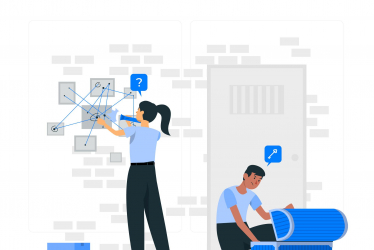Projects
CFI Chatbot to support humanitarian organisations
ChitChat is a chatbot designed at the Centre for Innovation in order to support relevant organisations in direct communication with people in crisis. It will help classify incoming messages from different channels, and share critical information in return.
How could a chatbot be important?
Communication with communities is a critical part of humanitarian response. It is essential in order to understand the needs of local communities and to provide effective feedback. This will allow communities to become more empowered and directly engaged in decision-making.
The increase in mobile connectivity and use of instant messaging platforms (such as Facebook and WhatsApp) opens new communication channels with people in crisis. It allows humanitarian organisations to directly communicate with local communities. However, this can pose considerable challenges for humanitarian organisations, as it requires finding ways to adequately process and respond to the possible large amounts of incoming messages.
What might be relevant applications?
Together with different humanitarian organisations, we have identified possible applications for the use of chatbots in humanitarian contexts. These range from remote data collection and allowing communities to indicate their needs, to answering questions and providing critical information in return.
In order to understand whether a chatbot could actually be of benefit to humanitarian organisations, we have to understand how they can adopt it in support of their operations. Therefore, we aim not only to explore whether it is technically feasible for a chatbot to facilitate these foreseen applications, but also to figure out how both humanitarian organisations and communities could work with such a system in different operational contexts.
Why do we build our own chatbot?
In relation to the various foreseen applications, we have been able to identify different requirements for a chatbot in humanitarian contexts.
Amongst others, it was considered critical to provide transparency of the classification of incoming messages and ensure security when directly communicating with people at risk. Additionally, the chatbot should support conversations in different language and scripts according to which conversations take place. Thus, the chatbot has to be easily adaptable ìn order to account for changes in highly volatile contexts.
On the basis of the listed of requirements, we have conducted a review of existing systems and applications. As not any of these systems was able to meet all of the requirements, guarantee sufficient data protection and/or keeps its code proprietary, we decided to build our own chatbot.
How does ChitChat work?
A chatbot simply automates the process of classifying and responding to incoming messages. In humanitarian contexts, it is critical that this process is transparent so that it is clear how certain messages are interpreted and certain responses have been prompted.
ChitChat, therefore, allows humanitarian responders to define certain rules according to which this process takes place. This also helps responders to easily review conversations in order to assess and understand the classification process.
To support the classification process, various natural language processing components have been implemented in the tool. This, for example, improves the classification of incoming messages by identifying typos or certain key entities.
What’s next?
Together with different partners, we will test how ChitChat could support their operations. Our collaboration with Radio Dabanga (Free Press Unlimited) explores whether it can allow their audiences to report relevant events through online communication channels and retrieve news updates in return.
Moreover, together with World Food Programme, we are testing how ChitChat could complement existing helplines for beneficiaries and allow to provide information back to communities, for example on food prices and assistance programmes.
Through this process, we do not only aim to understand whether a chatbot could facilitate relevant applications for humanitarian organisations, but also what is required in order to implement such a system. This requires us to reflect on broader adoption channels, such as to assess whether communication channels and/or instant messaging platforms with which a chatbot might be integrated offer adequate security.
Together with our growing list of partners, we want to explore the potential of chatbots to support direct communication with people in crisis. Feel free to connect us if you would like to engage in this process and explore whether this could add value to your operations.




